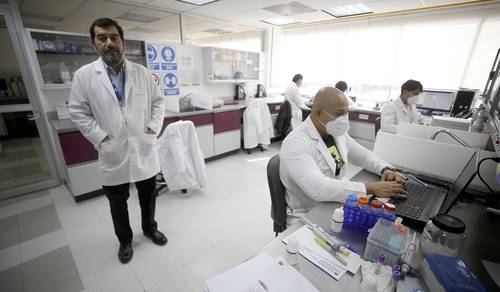
Juan Carlos Zenteno, Director of the Rare Disease Diagnostic Unit.Photo Jose Antonio Lopez
Fernando Camacho Servin
La Jornada Newspaper
Saturday, March 30, 2024, p. 10
From the time she was 9 months old until she was almost 30, Amalia Rojas lived without knowing why her skin became irritated, dry, and flaky, with uncomfortable itching all the time.
“When I was born, they noticed I had a ‘cap’ on my skin that wouldn’t fall off. They took me to several doctors and asked what I had, but they did not answer: some said it was fish or crocodile skin, or that they had never seen anything like it. I’m from Nogales, Veracruz, and because it’s a small town, they said it could be witchcraft,” says the young woman.
Until she consulted a specialist in rare diseases, she and her family were not able to learn that her condition was lamellar ichthyosis, a disease that has many documented cases in the high mountain region of Veracruz, but which is still Relatively unknown…
After carrying out a series of genetic studies, the specialists treating Amalia recommended that she use lots of skin creams, hydrate herself as much as possible, eat a healthy diet and get a little exercise. This way she has been able to deal with the itching and dryness that has been troubling her since childhood.
Despite all the difficulties, knowing the name of her condition and how to treat it has given her a different and more optimistic outlook on herself and her future.
“It’s good to know about it and not be put off. My sister had tests to look for the diseased gene and she came back ‘clean’. “It makes me happy that their kids can be born healthy, and it makes me happy too, if at some point I wanted to get married, to know if I could have a baby and my baby would be okay,” she says simply. Defines.
Cases like Amalia’s are treated every day at the Rare Disease Diagnostic Unit (UDER) of the Faculty of Medicine of the National Autonomous University of Mexico (UNAM), whose director, Juan Carlos Zenteno Ruiz, indicated in an interview. Day The center opened its doors in June 2022.
UDER was created with the aim of being an option where patients can have and review comprehensive genetic studies. We have been open for a little over a year and a half and have had over 400 patients, 300 of whom have already been studied and in many cases already have a definite diagnosis.
he explained.
The expert explained that a rare disease, by definition, is one that has a frequency of one patient for every 2,000 people, and estimated that between 8 and 10,000 such conditions have been registered so far, although they are constantly being studied. Is and discovered. Ahead.
long pilgrimage in search of truth
Zenteno lamented that, due to the lack of common knowledge about these diseases, patients often have to endure for many years the so-called pilgrimage or journey
Diagnosis, during which they go from one doctor to another without knowing what they have or how to treat it.
In this special center of UNAM, he highlighted, exome sequencing studies are carried out, through which a complete analysis of the 23 thousand genes of the human being is carried out. It’s a sweep of all a person’s genetic material to be able to look for any changes, and that’s what will give you the answer, because 80 percent of rare diseases are of genetic origin.
,
Carrying out these studies – for which UDER users pay affordable costs according to their possibilities – prevents patients They have to undergo tomography scans, MRI, biopsies, possible surgery and many studies that will not give you information. We save them from a lot of expenses as well as emotional and emotional burden.
,
The geneticist emphasized that although some rare diseases require more specific and complex treatments, such as providing the body with substances it does not naturally produce, there are many others that are better treated. Treatment is based on careful diet and avoiding certain medications. Take control of situations. Avoid current impacts and avoid future impacts.
When asked what is the importance of an organization like UNAM being involved in these issues, Zenteno defined: This is a public health problem and the mission of the Faculty of Medicine is to bring study and evaluation to more patients. This shortens the diagnostic process and undoubtedly has a positive impact on the health of patients.
,
(tagstotranslate)news
 Play Crazy Game Trusted Gaming News Portal
Play Crazy Game Trusted Gaming News Portal



